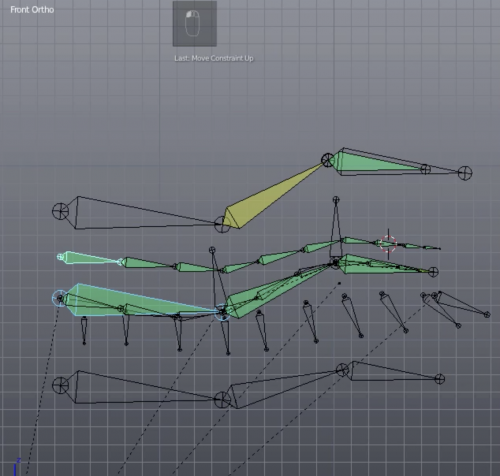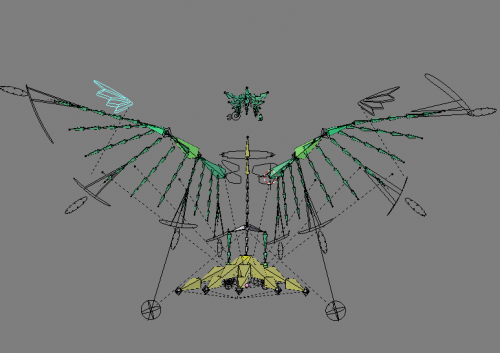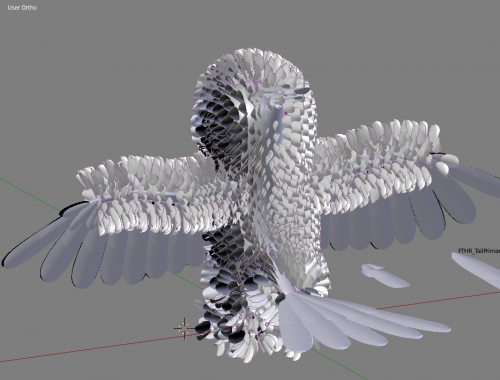
Article: Be a Beginner!
Article from the Muse News newsletter March 2018:
Oh dear, it's been too long since my last Muse News newsletter. I thank all of you who emailed me to make sure everything was OK. Yes, all is well here and I'm excited about getting this newsletter out to you and sharing some of the things I've been working on including some new pieces on my website. I also want to thank all of you who have subscribed to Muse News. Our subscriber count is now over 600! Yay!
Have you ever dreamed about learning something completely new but you didn't want to be a beginner again? Well, the reason why my newsletter has been missing for a while is because I took time off to be a BEGINNER again and I'm so glad I did! I'd love to share my thoughts with you about my two adventures in learning 3D animation and knitting and how becoming a beginner gave me new perspectives in music.
Just a little back story here: after being a professional oboist and English horn player for many, many years (40+), I got used to being a person with a higher skill level and that was a good feeling but it was also stressful. I noticed my attitude towards playing in symphony and various ensembles was changing and for some reason the joy of playing was slipping away. So in 2005, I gave myself permission to be a beginner again and I took up the harp. At first I thought it was only going to be a side hobby kind of thing but eventually the harp took over in my life. I loved playing it and writing music for it. Eventually my website filled up with over 100 pieces that I lovingly composed and arranged for the harp. I also enjoyed all the new people I met through the harp. What a lovely group of human beings! I often say that switching to harp was one of the best ideas I ever had.
It's contagious! Several years later my husband David who was a gifted French horn player in the symphony saw the positive results of me switching to the harp so he switched to the cello. I could tell he loved it. The excitement in his voice when he talked about something new he was learning in his cello lessons was so wonderful. We used to have a trio for English horn, French horn, and piano which we loved but now we are playing harp and cello duets together. We're not at the same skill level we had on our wind instruments but we're having a lot more fun. Learning a new instrument really opened our eyes up to different perspectives in music and life. The experience was so positive to me that I designed an infographic to encourage others to do the same called “Why Learn a Second Music Instrument”.
Now for something REALLY different - I still love playing the harp and writing music for it but a couple of years ago I had a desire to once again learn something new, this time something COMPLETELY different, something outside of music. I had always wanted to learn 3D animation. I thought it would be fun some day to combine some of my music with animation. I found a 3D animation program called Blender. It was very powerful with lots of features. It was an open source program which meant to me that it would always be evolving. However, the best part was that Blender was FREE. The first time I opened up a new document in Blender, I was totally lost. I had no idea how to do ANYTHING in the program. There was a cube in the middle of the default document and I didn’t know how to move it or how to manipulate it in any way. I had no clue how to move around in 3D space. I was in the truest sense of the word a BEGINNER! It was exciting… it was frustrating… it was time to start searching for tutorials on the University of YouTube!
The wonderful world of online video tutorials! Don’t we live in a wonderful time in history? We can learn so many new things through video tutorials thanks to the generosity of others. Name whatever subject you want and there’s probably an online video tutorial waiting to help. Although I've heard some people do not learn from videos very well, I personally love them since I live way out of town and I appreciate the endless opportunities to learn in the comfort of my own home. If you have never explored the world of video tutorials before, just remember that the art of making video tutorials is still developing. There are currently many excellent video tutorials online and some, well, not so helpful but I still appreciate someone freely sharing their knowledge.
I tried some Blender video tutorials aimed for the novice and they were pretty good. For example, I followed an easy tutorial where you make a cute little alarm clock that twists and turns as the hands rotate around. The tutorial was easy to follow and I was pleased with my result. (BTW, there is no sound in this video.)
Learn the basics! I then went on to follow many other Blender video tutorials but after completing them I realized that I was learning how to use the software “by rote”. I could follow the tutorial instructions: hold down this key and tap here, press this key and it will bring up another dialog box, etc (monkey-see, monkey-do) and I achieved the final results of each tutorial (well, a lot of them) but if I wanted to create a project of my own, I really didn’t know how to get there. It was hard to admit but I didn’t truly understand how this program worked. I NEEDED TO LEARN THE BASICS.
I came across a great set of Blender 3D Animation lessons done by Neal Hirsig. If you’ve ever tried to learn things through video tutorials, you know that there are some people who are gifted in explaining and demonstrating things through video. They take the time to really give you the basics. They show you the where, why, and how something works and they give you exercises to test what you’ve learned. Thanks to Neal’s series I felt like I better understood how Blender worked and it helped me to then go on to other video tutorials with better understanding and much more confidence.
By understanding the basics, I had a lot more fun following the tutorial from the Wayward Art Company and created this animation of Ringtail Dave. Some of the major steps in creating something like this on computer involves sculpting a character, retopologizing it, texturing and coloring it, adding fur to it, rigging it, animating it, and sychronizing it to a recorded voice. I had so much fun with the voice synchronization using David's voice.
Another tutorial from CG Cookie’s Ken Trammel called Piero was an extremely lengthy series but once again, because I learned the basics first, I enjoyed the tutorial so much more. Creating the movement of a flying bird in 3D is quite tricky! Like the Ringtail Dave animation I had to do all of the same major steps I mentioned before. The rigging of the wings was the biggest challenge but again, I enjoyed synchronizing sounds and adding some harp music in the background of my animation.
Just to give you a quick behind the scenes look at what goes into preparing a character like Piero, here are a few screen shots of the wing rigging and what the body feathers looked like before combing them:



The first thing I can tell you about learning 3D animation is that I have an enormous appreciation for Disney, Pixar, and all of those other animation studios. I had heard that sometimes it can take an animator an entire week to create 7 seconds of an animation and I believe it!
What does all of this have to do with music? When I finally realized how important learning the basics in anything was, I got one of those “aha” moments. Think about music instruction. Are we learning music “by rote” where the teacher plays the piece for us and then we mimic it back? Are we listening to recordings or watching videos to find out how a piece sounds? I'm not talking about listening/watching for interpretation or nuance ideas. I'm asking are we listening/watching just to know how the song goes? I remember when I started saxophone in junior high. There were lots of other sax players in the row and I never felt the pressure of having to learn the rhythms or how to count measures because I had the group to follow. Then I switched to oboe and I was alone. I HAD to learn how to read the rhythms and count for myself! Once the concept of rhythm finally sank in, I was much better off and felt good about it.
A master key for many doors - Are we teaching our students by rote? Certainly, there are times that demonstrating can be very beneficial because some elements of music can best be understood by listening to an example. However, there are many basics in music such as rhythm. At first, learning rhythm does require a mimicing stage but eventually there needs to be a true understanding of how rhythm basically works. As teachers, we want our students to learn how to read rhythm for themselves but how many times have we found that it’s faster and easier to just tell them, “This is how it goes.” I know how hard it is to tell a student, “No dear, I think YOU can figure this rhythm out by yourself.” However, we’re really doing the student a favor because helping them to understand these early basics can be like giving a student a master key to many doors. I learned from my 3D animation experience that if I had not taken the time to understand how the program’s basics worked, I would probably never had gotten past the "monkey-see, monkey-do" stage and be locked out to future possibilities.
Do we really remember what it was like? Another “aha” moment I had on the 3D program experience was I had forgotten what it felt like to be a beginner learning a complex skill. We learn new things every day but how often do we begin learning something new that requires a month or more to comprehend? I don't think many of us truly remember what it’s like to be a music rookie learning all the complexities of music until we attempt something new that is also complex. I’ve been using the Finale music software program for many years and when I heard someone complaining that it was too difficult to learn, that puzzled me. Yes, Finale is a sophisticated program but it didn’t seem that difficult to me. Then I got to thinking, those first few months of learning Finale were so faded in my mind that I had forgotten what it was like. After taking those baby steps with the 3D program, I had much more empathy for that new Finale user. We can easily forget what it’s like to be a beginner unless we become a beginner too. By taking the time to be a true newbie, we gain a clearer perspective and a better understanding for teaching.
What do the Danes know that we don't? You may find it interesting to know that the citizens of the Denmark workforce are allowed and encouraged to change jobs every year. Can you imagine changing jobs every year and being a beginner as a normal way of life? What might we gain from following a policy like that? You might also find it interesting that the citizens of Denmark are recognized as the happiest people in the world. Hmmm
Thanks for reading this article and looking at some of the 3D examples I’ve completed. If you would like to see other 3D experiments I’ve done, I have a playlist on my YouTube channel: My Blender Examples. I will have another beginner experience to share with you (about knitting) in my next newsletter. I look forward to telling you about the ideas and perspectives I learned from the knitting community that helped me see things differently in music. I hope this article gave you something to think about and if it inspired you to start something new, I’d love to hear about it. Also, if you have some beginner “aha” moments of your own that you would like to share, please send me a message through my contact form.
